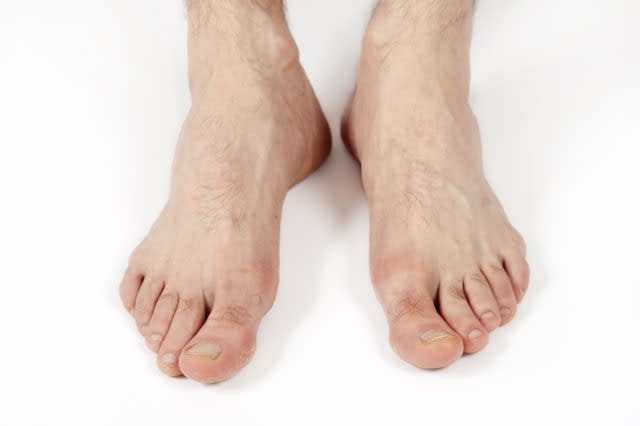Seven foot problems that can signal something serious

They carry you around all day, but you rarely give them a second thought - until something goes wrong. While many foot issues are caused by everyday wear and tear, others can be a sign of something more serious. Here are seven foot problems that can suggest an underlying medical condition.
See also: What to eat (and what to avoid) if you have gout
See also: Seven signs of cancer that can be easy to miss
1. Dry, flaky feet
If your feet are dry and flaky no matter how much moisturiser you use, it could be a sign of a thyroid problem. The thyroid gland, located at the base of your neck, produces hormones which help to regulate metabolic rate, blood pressure, tissue growth, and skeletal and nervous system development. If it's not working as it should, the result can be dry flaky skin. Brittle toenails can also signal a thyroid problem.
2. Ulcers that don't heal
If you have ulcers on your feet that don't seem to heal, it could be a sign of diabetes. When the body can't control glucose levels, it can cause nerve damage and poor circulation, which means the blood may not get pumped to the feet properly. Because of this, any wounds or cuts don't get the chance to heal properly. Many people only find out they have diabetes because of problems with their feet. If you notice a tingling sensation or numbness in your feet, which can also signal diabetes, it's important to see your doctor.
3. Enlarged, painful big toe
If the joint of your big toe feels hard, swollen and painful, you could have gout. You don't have to eat rich foods or drink port to suffer from the condition, which affects a surprisingly number of older people. It's caused by having too much uric acid in the body. Normally, the body excretes it through urine, but some people produce too much of it, and not enough is excreted from the body. Your doctor may give you anti-inflammatory drugs for short-term relief. You can help prevent another attack by following a low-purine diet – that means cutting back on red meat, fish, and certain types of alcohol.
4. Spooned nails
If your toenails have a dip in them, giving them a 'spooned' appearance, it could be a sign that you have an ironic deficiency (anaemia) or that your body produces too much iron (hemochromatosis). Koilonychias, to give it its medical name, can also be a sign of Raynaud's disease, which is caused by poor circulation. It can also sometimes be a sign of lupus - an autoimmune disease in which the body's immune system attacks cells, tissues, and organs. If your toenails have a spooned appearance, it's best to see your doctor who can take a blood test to see if there's an underlying cause.
5. Clubbed toes
If you notice clubbing in your toes or fingers – they appear rounder and wider – it could be a sign of lung cancer or heart disease. Both of these conditions decrease vascular resistance, which means blood flow to the small arteries in the toenails and fingertips will increase. As a result of the tissue swelling, the toes and fingers can take on a "clubbed" appearance. Clubbing in the toes or fingers can also signal other serious conditions, such as chronic lung infection and intestinal disease, so it's important to see your doctor if you spot any abnormalities.
6. Discoloration in your toes
You check your face and body for new moles – particularly ones that are irregular in shape or colour – but do you know to check your feet? If you notice an unusual mole or lump on the top or bottom of your foot or between your toes, it's worth getting it checked out. Skin cancer can also show as a discoloration of the toenails. If you notice dark spots under the nail, not caused by a recent injury, or a black vertical line that goes from the base of your nail to the tip of the nail, it's important to see your doctor.
7. Cold feet
If your feet are constantly cold, it could suggest a problem with your circulation. Men over 50 are most likely to be affected by peripheral artery disease (PAD), a narrowing of the arteries that reduces blood flow and can result in numbness, foot and lower leg coldness, and leg pain. PAD can cause the muscles in your calves and other parts of your legs to cramp while you're moving around, and can also lead to foot pain and poorly healed foot wounds. The disease is associated with a higher risk of heart attack and stroke, so it's important to be diagnosed. Cold feet could also signal Raynaud's disease, hypothyroidism or diabetes – so don't ignore it, get it checked out.



